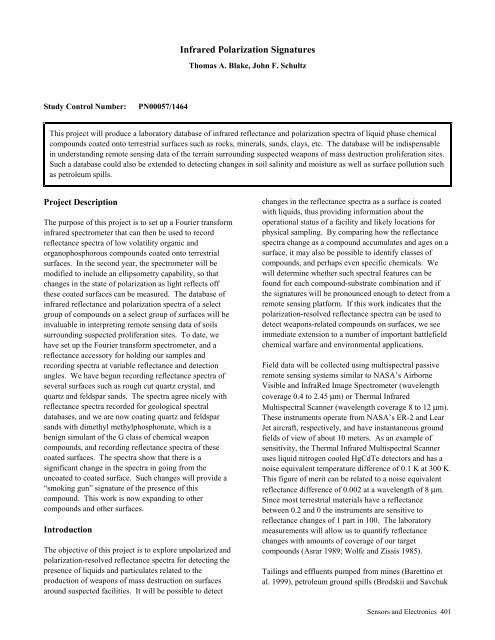PNNL-13501 - Pacific Northwest National Laboratory
PNNL-13501 - Pacific Northwest National Laboratory
PNNL-13501 - Pacific Northwest National Laboratory
You also want an ePaper? Increase the reach of your titles
YUMPU automatically turns print PDFs into web optimized ePapers that Google loves.
Study Control Number: PN00057/1464<br />
Infrared Polarization Signatures<br />
Thomas A. Blake, John F. Schultz<br />
This project will produce a laboratory database of infrared reflectance and polarization spectra of liquid phase chemical<br />
compounds coated onto terrestrial surfaces such as rocks, minerals, sands, clays, etc. The database will be indispensable<br />
in understanding remote sensing data of the terrain surrounding suspected weapons of mass destruction proliferation sites.<br />
Such a database could also be extended to detecting changes in soil salinity and moisture as well as surface pollution such<br />
as petroleum spills.<br />
Project Description<br />
The purpose of this project is to set up a Fourier transform<br />
infrared spectrometer that can then be used to record<br />
reflectance spectra of low volatility organic and<br />
organophosphorous compounds coated onto terrestrial<br />
surfaces. In the second year, the spectrometer will be<br />
modified to include an ellipsometry capability, so that<br />
changes in the state of polarization as light reflects off<br />
these coated surfaces can be measured. The database of<br />
infrared reflectance and polarization spectra of a select<br />
group of compounds on a select group of surfaces will be<br />
invaluable in interpreting remote sensing data of soils<br />
surrounding suspected proliferation sites. To date, we<br />
have set up the Fourier transform spectrometer, and a<br />
reflectance accessory for holding our samples and<br />
recording spectra at variable reflectance and detection<br />
angles. We have begun recording reflectance spectra of<br />
several surfaces such as rough cut quartz crystal, and<br />
quartz and feldspar sands. The spectra agree nicely with<br />
reflectance spectra recorded for geological spectral<br />
databases, and we are now coating quartz and feldspar<br />
sands with dimethyl methylphosphonate, which is a<br />
benign simulant of the G class of chemical weapon<br />
compounds, and recording reflectance spectra of these<br />
coated surfaces. The spectra show that there is a<br />
significant change in the spectra in going from the<br />
uncoated to coated surface. Such changes will provide a<br />
“smoking gun” signature of the presence of this<br />
compound. This work is now expanding to other<br />
compounds and other surfaces.<br />
Introduction<br />
The objective of this project is to explore unpolarized and<br />
polarization-resolved reflectance spectra for detecting the<br />
presence of liquids and particulates related to the<br />
production of weapons of mass destruction on surfaces<br />
around suspected facilities. It will be possible to detect<br />
changes in the reflectance spectra as a surface is coated<br />
with liquids, thus providing information about the<br />
operational status of a facility and likely locations for<br />
physical sampling. By comparing how the reflectance<br />
spectra change as a compound accumulates and ages on a<br />
surface, it may also be possible to identify classes of<br />
compounds, and perhaps even specific chemicals. We<br />
will determine whether such spectral features can be<br />
found for each compound-substrate combination and if<br />
the signatures will be pronounced enough to detect from a<br />
remote sensing platform. If this work indicates that the<br />
polarization-resolved reflectance spectra can be used to<br />
detect weapons-related compounds on surfaces, we see<br />
immediate extension to a number of important battlefield<br />
chemical warfare and environmental applications.<br />
Field data will be collected using multispectral passive<br />
remote sensing systems similar to NASA’s Airborne<br />
Visible and InfraRed Image Spectrometer (wavelength<br />
coverage 0.4 to 2.45 µm) or Thermal Infrared<br />
Multispectral Scanner (wavelength coverage 8 to 12 µm).<br />
These instruments operate from NASA’s ER-2 and Lear<br />
Jet aircraft, respectively, and have instantaneous ground<br />
fields of view of about 10 meters. As an example of<br />
sensitivity, the Thermal Infrared Multispectral Scanner<br />
uses liquid nitrogen cooled HgCdTe detectors and has a<br />
noise equivalent temperature difference of 0.1 K at 300 K.<br />
This figure of merit can be related to a noise equivalent<br />
reflectance difference of 0.002 at a wavelength of 8 µm.<br />
Since most terrestrial materials have a reflectance<br />
between 0.2 and 0 the instruments are sensitive to<br />
reflectance changes of 1 part in 100. The laboratory<br />
measurements will allow us to quantify reflectance<br />
changes with amounts of coverage of our target<br />
compounds (Asrar 1989; Wolfe and Zissis 1985).<br />
Tailings and effluents pumped from mines (Barettino et<br />
al. 1999), petroleum ground spills (Brodskii and Savchuk<br />
Sensors and Electronics 401

















